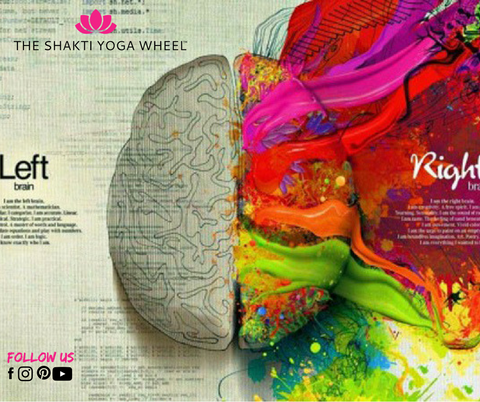Left Brain Right Brain
Left Brain Right Brain
What the Ancient Yogis Knew to Be True So Long Ago
Ancient yogis knew things thousands of years ago that our modern world is only recently recognizing. The earliest texts of meditation date back to 1500 BCE, but only now, in that past 50 years or so has meditation become mainstream. Rather than discipline children with behavior problems through detention or suspension, many schools have started teaching these children meditation and mindfulness practices. Meditation is being used as a therapy for children with ADHD, sensory processing disorders and those who are on the autism spectrum. It is being taught to individuals suffering with PTSD, to those with drug and alcohol addictions, to victims of abuse, and even to those who are incarcerated in our prisons.
In addition to meditation, the scientific community is now talking a lot about pranayama, the ancient art of breath control. We are just beginning to really recognize how important the breath is in regards to our physical, emotional and mental health. Meditation and pranayama are practices yogis in India have had for over 5,000 years. It is nice that we are finally catching up!
Science tells us that, at any given moment, one of your nostrils in more open than the other. Scientists have discovered that when the right nostril is dominant, the brain activity is greater in the left cerebral hemisphere. When the dominant nostril switches, so does the activity in the brain hemisphere. They call this “alternating dominance of cerebral hemispheric activity.” Functions and movements in the body are controlled by the opposite side of the brain. It is the right hemisphere of the brain that controls the left side of the body, and, conversely, the left hemisphere of the brain controls the right side of the body. Got it? Ok.
We know that the right and left hemispheres of our brain process reality differently, affecting the way we see the world. The right hemisphere of our brain is the more creative side. The right brain lives in the now and is excited by new experiences. Everything the right brain takes in is vibrant and vivid and full of sensation. The left hemisphere takes all of these vibrant moments and organizes them into categories and lists. The left brain is the more analytical side and loves the familiar.
So if it is true that when one brain hemisphere has more activity, the opposite side nostril is more dominant, it would be correct to assume that when you are doing your taxes, using the left brain, your right nostril would be more open. And if you were using the creative right brain, let’s say you were painting or dancing the tango, your left nostril would be more open.
This is kind of fascinating. And guess what? The ancient yogis knew this, too. They looked deep into the mysteries of the mind and the subtle body, studying the immeasurable, the invisible. They wanted to understand the levels of energy and vibrations pulsing throughout our body. Yogis believe in prana. Prana is a cosmic energy. It is the life force, the breath within the breath. Among the ancient yogis’ most important discoveries were the nadis. In Sanskrit, nadi means “stream” or “flow” and is the vast network of energy channels that allow prana to move throughout the body.
According to Tantric Yogic texts, we have 72,000 nadis in our energy body that deliver prana to every cell. These 72,000 nadis spring from three fundamental nadis-the left, the right and the central. The Sushumna Nadi is the central channel, running along the spine. It is here where all 7 chakras align.
The left channel is called Ida Nadi and runs along the left side of the body. Since the right hemisphere of the brain is in control of the left side of the body, Ida is right brain dominant. Ancient yogis associated the Ida Nadi with the moon. This is the feminine and creative principal. It is Ida Nadi who is responsible for passion, sensuality, imagination and vivid color. And this is completely in line with today’s modern theory for characteristics of the right brain.
The right channel is called Pingala Nadi and runs along the right side of the body. Pingala is left brain dominant and is associated with the sun. This is the masculine and analytical principle. It is Pingala Nadi who is responsible for organizing and categorizing our experiences. Pingala is accurate, practical and logical. Again, this is completely in line with how neuroscientists describe the right hemisphere of the brain.
Ida and Pingala represent the basic duality of existence. They are the masculine and feminine, the logical and the intuitive. Creating a balance between Ida and Pingala will make you more effective in the world, allowing you to have a more accurate experience of reality. And yoga is, in its essence, all about balance. Here are some right and left brain exercises you can do to help bring balance to your mind and body:
Cross Marching
Stand with your arms at your sides and your elbows bent at 90 degrees. Make a fist in each hand. Bring one knee up and tap the thigh with your opposite fist. Step that leg down and do the same thing with the other arm and leg.
Cross Arms and Hold Ears
Cross your arms in front of you and grab a hold of your earlobes, right hand to left earlobe and left hand to right earlobe. Inhale and squat down. Exhale to stand back up. To make this more challenging, stand with your ankles crossed. Bend your knees, inhale and come all the way to a seat. Then, without using your hands, exhale to come back up to standing.
Thumb and Pinky
Hold your hands in front of you and make fists. Bring the thumb of your right hand up, but keep all other fingers balled up. Bring the pinky of your left hand out, keeping all other fingers and thumb in the fist. Then switch. Put down the right thumb and release the right pinky. At the same time, bring in the left pinky and lift the left thumb up. And switch! Switch! Switch! Switch!
Figure 8
Standing up, extend your right arm out in front of you, with the thumb pointing toward the ceiling. In the air, smoothly and slowly trace the shape of a large figure 8 on its side. Do that for several seconds and then bend your left knee to hip height, standing only on the right foot. Now make a sideways figure 8 with your left knee. When your right hand moves toward the midline, (to the left), move your left knee also to the midline, (to the right). When the hand moves out, also move the knee out. Do both sides.
Spinal Balance
Come to hands and knees and tuck your toes. Extend the right leg back behind you and lift the foot off of the ground. Then reach your left arm straight forward, bicep in line with your ear. Hold for 3-5 breaths and switch.
Alternate Nostril Breathing
Sit in a comfortable position with the spine long and the hips relaxed. Release any tension from your jaw. Bend the index finger and middle finger of the right hand into the center of the right palm. Take in a big inhale breath. Place the right thumb on the right nostril and gently close the airway. Exhale out the left nostril only. Breathe in through the left nostril and then close with the ring finger. Release the thumb on the right nostril and breathe out through the right side. Inhale through the right nostril, close with the thumb, release the ring finger from the left side and exhale through the left nostril.
This is one round of Alternate Nostril Breath. Perform 9 rounds of this alternating breath between the nostrils. Remember to always inhale through the same nostril you just exhaled through. Allow the breath to be smooth and even without creating force or pressure.
~Author Elena Long



